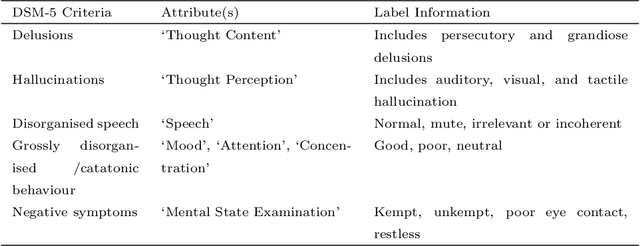RobIn: A Robust Interpretable Deep Network for Schizophrenia Diagnosis
Paper and Code
Mar 31, 2022



Schizophrenia is a severe mental health condition that requires a long and complicated diagnostic process. However, early diagnosis is vital to control symptoms. Deep learning has recently become a popular way to analyse and interpret medical data. Past attempts to use deep learning for schizophrenia diagnosis from brain-imaging data have shown promise but suffer from a large training-application gap - it is difficult to apply lab research to the real world. We propose to reduce this training-application gap by focusing on readily accessible data. We collect a data set of psychiatric observations of patients based on DSM-5 criteria. Because similar data is already recorded in all mental health clinics that diagnose schizophrenia using DSM-5, our method could be easily integrated into current processes as a tool to assist clinicians, whilst abiding by formal diagnostic criteria. To facilitate real-world usage of our system, we show that it is interpretable and robust. Understanding how a machine learning tool reaches its diagnosis is essential to allow clinicians to trust that diagnosis. To interpret the framework, we fuse two complementary attention mechanisms, 'squeeze and excitation' and 'self-attention', to determine global attribute importance and attribute interactivity, respectively. The model uses these importance scores to make decisions. This allows clinicians to understand how a diagnosis was reached, improving trust in the model. Because machine learning models often struggle to generalise to data from different sources, we perform experiments with augmented test data to evaluate the model's applicability to the real world. We find that our model is more robust to perturbations, and should therefore perform better in a clinical setting. It achieves 98% accuracy with 10-fold cross-validation.
 Add to Chrome
Add to Chrome Add to Firefox
Add to Firefox Add to Edge
Add to Edge